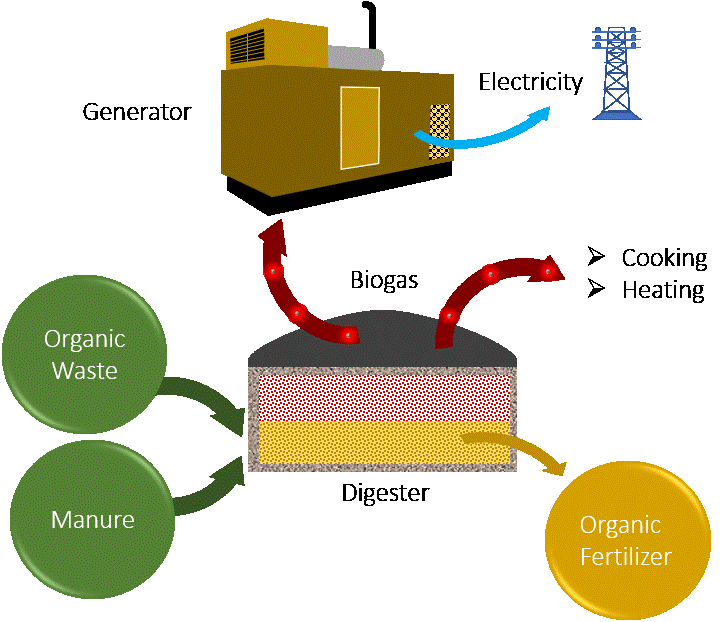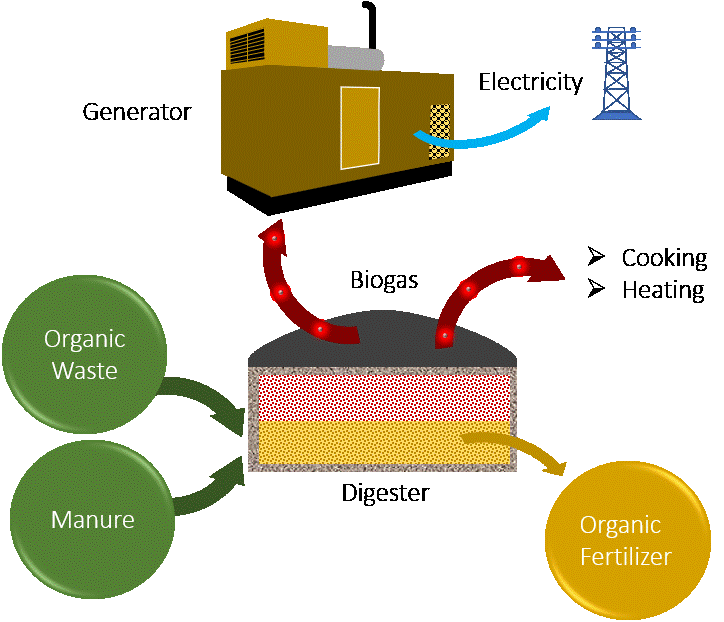MICROBES HELP FUEL ENERGY TRANSITION: NEED THE RIGHT HABITAT TO DO SO!
June 26, 2023
Scientists have long been studying the potency of methane—a climate warmer.
Methane (CH4) is considered to be a significant greenhouse gas. Microorganisms decompose organic matter in the absence of oxygen. They produce methane in soils as the end product1.
Biogas is not new. In 1808, Humphrey Davy made laboratory experiments to produce methane from manure. In 1895, Donald Camerson used methane gas from the first septic tank built by him in the English city of Exeter, for lighting streets near the treatment plant2.
A simple concept is applied to capture methane produced by organic matter instead of allowing it to escape into the atmosphere.
The methane-producing microorganisms cannot live in the presence of oxygen, therefore the digester has to be sealed from the environment. The digester is the most expensive component of the system, therefore it should normally be designed and constructed as small and as compact as possible2.
An anaerobic digester collects organic matter such as livestock manure and/or food waste. Biogas is produced when microorganisms break down organic material in the digester. Primarily consisting of methane—a flammable gas, the biogas is captured and then it is converted into electricity.
There are many applications of biogas systems. Biogas is used as a fuel in combustion engines, for cooking, and heating. Also, the anaerobic digestion process produces fertilizer.
Biogas contains humidity and sulphide acid (H2S) in addition to CO2. Water and carbon dioxide may pose a combustion challenge for the engines. H2S may cause corrosion in engines. Therefore, it is recommended to purify biogas3.
Microorganisms are sensitive to the conditions in their environment. Studies have been carried out to enhance the performance of anaerobic digestion. Research teams have looked at the effect of the biodegradability of substrates, temperature, pH value, hydraulic retention time, and carbon-nitrogen ratio on methane production.
The Penn State digester showed an average of 60% CH4 and 30%-35% carbon dioxide (C02).
In a study, researchers found that out of all the samples that were collected from the 07 different biogas plant reactors, one reactor with a mixture of the substrates including maize silage, sugar beet pulp, whole crop silage, cattle manure, and grass silage; produced the highest (52%) methane. Methane production was not dependent on the number of microorganisms that produce methane (methanogens) but on the type4.
Some studies have reported that the increase in methane production is significant after CO2 addition5.
- Edward Topp and Elizabeth Pattey. 2011. Soils as sources and sinks for atmospheric methane. Canadian Journal of Soil Science. 77(2): 167-177. https://doi.org/10.4141/S96-107
- Biogas from Manure, The Pennsylvania State University
- Suzuki.A.B.P, Fernandes.D.M, Faria.R.A.P & Vidal.T.C.M, (2011). Use of biogas in internal combustion engines, Brazilian Journal of Applied Technology for Agricultural Science, Vol. 4 (1), 221-237.
- Kushkevych, I., Vítězová, M., Vítěz, T., Kováč, J., Kaucká, P., Jesionek, W., Bartoš, M., & Barton, L. (2018). A New Combination of Substrates: Biogas Production and Diversity of the Methanogenic Microorganisms. Open life sciences, 13, 119–128. https://doi.org/10.1515/biol-2018-0017
- Nugroho, Wahyunanto (2021) Application of CO2 Microbubble to Enhance Methane Production in Anaerobic Digestion of Food Waste. PhD thesis, University of Sheffield.

Home | Contact: info@gazersdigest.com
© 2020-2025 Gazer’s Digest is an information sharing platform. Gazer’s Digest includes topics, thought to be useful for the readers.

